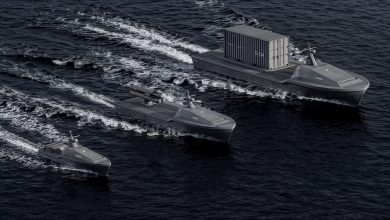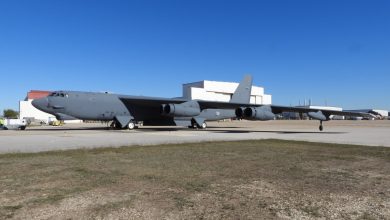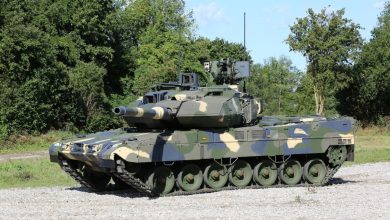Turkish, Greek defense chiefs stress dialogue to ease renewed tension

Turkish Defense Minister Hulusi Akar met with his Greek counterpart Nikos Panagiotopoulos on the sidelines of a NATO meeting in Brussels and discussed maintaining dialogue to ease recently heightened tensions, the Turkish Defense Ministry said
The ministry also said the two discussed keeping communication lines open to solve problems and that focusing on positive bilateral agendas contributes to good neighborly relations.
The discussion in Brussels between Akar and Panagiotopoulos focused on the “importance of continuing the dialogue in order to reduce tensions,” according to a ministry statement.
They discussed the need to keep channels of communication open to focus on a positive agenda and bilateral and regional cooperation, according to the statement.
Turkey is in favor of dialogue to solve problems with Greece but some Greek politicians escalate tensions for the sake of their personal and political ambitions, Akar also said earlier this week.
“The problems between the two countries cannot be solved without talks, meetings, visits and dialogue. We want dialogue,” Akar said.
He continued by saying that some Greek politicians “unfortunately” escalate tensions for the sake of their own ambitions.
Akar also criticized Greece for discussing Turkey-Greece problems with the European Union rather than Ankara.
“They try to make it seem like our bilateral issues are the issues of the EU, the U.S. or NATO,” he said, adding that including third parties in the problem will not help solve it.
Long-existing tensions between the neighboring countries flared up again recently, with Ankara saying that Athens should stop arming islands in the Aegean Sea that have a demilitarised status and abide by international agreements.
Ankara says the Aegean islands were given to Greece under the 1923 Lausanne and 1947 Paris treaties on the condition it does not arm them.
Athens has said that Turkey’s remarks about it arming the islands are unfounded. The two countries, which are NATO members but have long been at odds over a range of issues, have both sent letters to the United Nations outlining their rival positions on airspace and the islands.
President Recep Tayyip Erdoğan said last month that Greek Prime Minister Kyriakos Mitsotakis “no longer exists” for him, accusing the Greek leader of trying to block sales of F-16 fighter jets to Turkey during a visit to the United States. Last week, Erdoğan announced that Turkey was halting all bilateral talks with Greece that started in 2021.
He also warned Greece to demilitarize islands in the Aegean, saying he was “not joking.” He spoke during Turkish wargames near the Greek islands that included an amphibious landing scenario.
Mitsotakis said on Tuesday that Turkey’s position that questions Greece’s sovereignty over its Aegean islands is “absurd,” and renders any talks between the two countries difficult. He also said the two leaders would inevitably meet at some point and they should not stop talking to each other.
He also sought to reassure his compatriots, saying that despite strong rhetoric from Turkey, relations are not at the low of 2020 when the neighbors’ warships were shadowing each other in the Eastern Mediterranean.
The two NATO allies have long been at odds over a number of issues including offshore rights, ownership of uninhabited islets, competing claims over jurisdiction in the Eastern Mediterranean, overlapping claims over their continental shelves, maritime boundaries, airspace, energy, the ethnically split island of Cyprus, the status of the islands in the Aegean Sea and migrants. They have come close to war three times in the past half-century, while NATO stepped in when a dispute over drilling rights for potential oil and gas deposits in the Eastern Mediterranean Sea led to a tense naval standoff in the summer of 2020. Greece has since embarked on a major military modernization program.
NATO Secretary-General Jens Stoltenberg on Tuesday urged Turkey and Greece to resolve their disagreements over the Aegean Sea, where the two are at loggerheads over islands and airspace.
“Diverse views and debate are an essential part of our democracies,” the head of the trans-Atlantic military alliance told Greek news agency ANA.
But, he said, “we urge Greece and Turkey to solve their differences in the Aegean in a spirit of trust and Allied solidarity.”
“That means restraint and moderation, and refraining from any actions or rhetoric that could escalate the situation.”
On the other side, Greek media and politicians accused NATO’s chief Wednesday of not being “unbiased” toward Turkish-Greek relations, while Turkey called on Germany to be impartial by calling the remarks made by a German Foreign Ministry spokesperson regarding Greece’s unlawful claims on the disputed issues between Athens and Ankara “unfortunate.”
During a press conference on Wednesday, German Foreign Ministry spokesperson Christian Wagner said that recent statements by the Turkish government “do not help the constructive dialogue and stability in the region,” while “the aggressive rhetoric especially, as well as Turkish violations of the Greek airspace, give cause for concern.”
Responding to the remarks, the Turkish Foreign Ministry said in a statement that the “baseless allegations” by the German spokesperson are “unacceptable,” adding that it is Greece that violated Turkish airspace and made flights over its mainland.
“We would like to remind the German spokesperson that despite the invitations to the bilateral and NATO Confidence-Building Measures meetings, it is not Turkey that has not responded for a year and has announced that it has frozen these meetings using the latest tension in the Aegean as an excuse,” he said.
The ministry called on Germany, which claims to make efforts for dialogue and de-escalation, “not to take sides in the disputes between the two allies, not to be an instrument to the lawlessness of other countries, and not to make biased comments on the areas and issues in which it has no authority and responsibility.”
Moreover, Akar on Thursday had talks with his European counterparts at NATO headquarters in Brussels.
Participating in the sessions on the alliance’s deterrence and defense, Akar later attended a family photo shoot on the second day of the NATO defense ministerial meeting, a precursor to the leaders’ summit scheduled for June 29-30 in Madrid.
On the sidelines of the meeting, he had talks with his Lithuanian, Latvian, Albanian and French counterparts, separately, discussing regional defense and security issues.
During the meeting with his French counterpart, Akar and Sebastien Lecornu exchanged views on bilateral and regional defense and security issues as well as steps to enhance cooperation in the defense industry.
Earlier Thursday, Akar also met with British Defense Secretary Ben Wallace and his Ukrainian counterpart Oleksii Reznikov on the sidelines of the NATO Defense Ministers Meeting in Brussels to discuss regional defense and security issues, as well as the latest developments in Ukraine, facing war from Russia that started on Feb. 24.
The Turkish defense chief on Wednesday arrived at the NATO headquarters in Brussels to attend the defense ministers’ meeting to be chaired by the secretary-general of the alliance.





